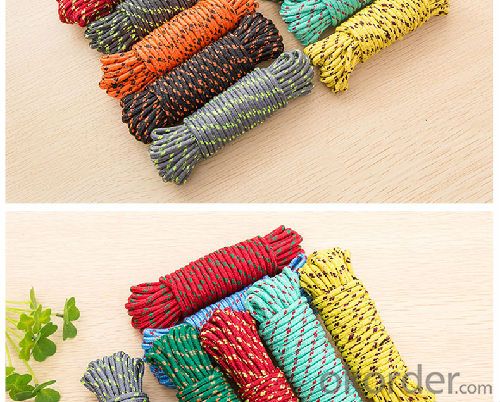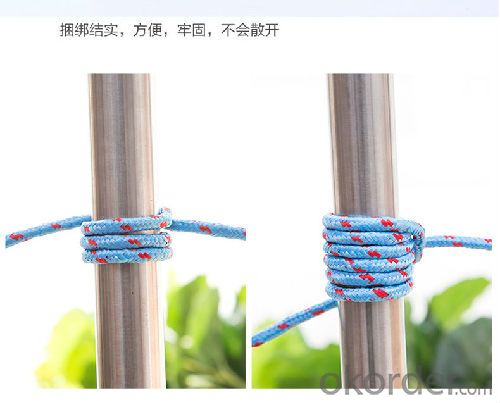Loading Port:Ningbo
Payment Terms:TT or LC
Min Order Qty:1000 g/m
Supply Capability:500000 g/m/month
The description of Clotheslines
Our clotheslines have many specifications and made from PVC/PP, nylon , PP twisted, retractable line etc. We can produce according to customer's requirements concerning diameters, length, material, packaging etc.
A clothes line or washing line is any type of rope, cord, or twine that has been stretched between two points (e.g. two sticks), outside or indoors, above the level of the ground. Clothing that has recently been washed is hung along the line to dry, using clothes pegs or clothespins. Washing lines are attached either from a post or a wall, and are frequently located in back gardens, or on balconies. Longer washing lines often have props holding up sections in the middle due to the weight of the usually wet clothing.
The specification of clotheslines :
Material : nylon
Diameter :4mm 6mmm 8mm etc
Length :10m Weight :95g
Size: as customer’s requests
Colors: all colors are available
Application : clotheslines or other applications
Features of clotheslines :
Easy to install .
Cheaper and colorful
Advantage of clotheslines:
Hanging clothes on a line instead of using a dryer is more economical, as well. Do you ever wonder where all that dryer lint originates? From your clothes, of course! Dryers wear out clothes faster than the more “old-fashioned” method of line drying.
Dry Your Clothes on a Clothesline
FAQ
INSTALL A POLE-TO-POLE CLOTHESLINE
Step 1: Choose a location
Buy a set of ready-made clothesline poles. When choosing a location, keep your clothesline away from wires and trees or any objects where birds may perch. It is also good to install the clothesline away from high-traffic areas in your yard where children and pets play. For privacy's sake, choose an area of your yard that has the least visibility to neighbors and passersby.
Helpful Tip
If possible, align the direction of the clothesline so that your clothes will receive the greatest amount of sunlight by running the line north to south. Your clothes will dry faster this way.
Step 2: Dig Holes
To permanently and securely install your clothesline poles you need to bury part of the poles in the ground so that they can support the weight of wet clothes on the line. Using a tape measure, map out how much space you want between your two poles and mark where you'll dig the two holes with chalk or paint. It's up to you how far apart the poles will be, but keep in mind that you want enough line space to hold all of your laundry, but too much line can sag in the middle and make wet clothes touch the ground when they're on it.
Using a post-hole digger, dig two equidistant holes – one for each pole. Make the holes about 12" - 18" deep and 12" wide. The bottom of the hole should be slightly wider than the top — this helps prevent any movement when the earth settles. Note: Pole height can vary a bit depending on how high you want your clothesline to be. Most poles are around 6' to 7-1/2' in height and can be found at your local True Value hardware store. In the end, you want the clothesline to be at the average height of a person or a couple inches taller to make it easy to hang clothes on.
Step 3: Plant the Posts
Fill one third of each hole with concrete mix, add water, and place each post into its hole. Then fill it the rest of the way with concrete. Use a level to ensure your post is straight then stake it in place with rope or heavy string so that it remains straight. Hint: This is much easier with an assistant. Let the concrete set for a day. After it is dry, remove the stakes and rope.
Step 4: String the Line
hanging clothes
Tie a good-quality, nylon clothesline to the ends of each pole "T" and then tie the other end of the rope to the opposite "T" in the same way.
Congratulations! Now you're giving your clothes dryer and the environment a break, not to mention you're saving money on energy costs.

